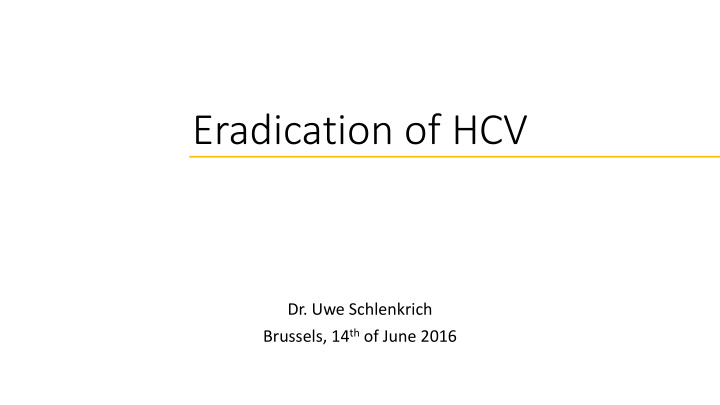



Eradication of HCV Dr. Uwe Schlenkrich Brussels, 14 th of June 2016
Personal Introduction • Born 1957 in Erfurt in East Germany (GDR) • Diagnosed with severe haemophilia in the first year • Treatment with blood and plasma till the middle of the 60ies • Followed by the treatment with cryoprecipitate till the fall of the wall, 1989 • Never had access to virus inactivated clotting factors till 1989 • HCV diagnosis in 1991 Dr. Uwe Schlenkrich 2
Causes of the HCV infection Treatment with blood, plasma and cryoprecipitate (not tested, not virus inactivated) Epidemiology of HCV in Germany (East and West): 0,3 % of the population; 1 in 300 persons is infected Risk of transmission is 1: 300 in blood or plasma transfusion or 1: 100 in cryoprecipitat (made of 3 plasma donations) Risk of transmission with high concentrates was 100% in the early 80ies (pool of 10.000 and more plasma donations) Dr. Uwe Schlenkrich 3
Risk for a PWH to get infected with HCV East West Germany Germany 4 4 3 3 risk risk 2 2 1 1 0 0 time time Dr. Uwe Schlenkrich 4
Personal experience with HCV • HCV diagnosis 1991 • first treatment with Interferon for over one year (side effects: sleepiness, tiredness, problems to focus) 1995 • combination treatment with Interferon and Ribavirin over 3 months 2003 • liver cirrhosis diagnosis 2010 • treatment with Interferon, Ribavirin and Telaprevir over 21 weeks (side effects: irritation of the skin) 2012 • treatment with Interferon, Ribavirin iv. , Silibinin and Telaprevir over 26 weeks (side effects: absolutely exhaustion) 2013 Dr. Uwe Schlenkrich 5
Personal experience with HCV Successful treatment in 2014 September – December 2014: treatment with Sofusbuvir + Daclatasvir and Ribavirin Dr. Uwe Schlenkrich 6
WHO Model List of Essential Medicines in 2015 Dr. Uwe Schlenkrich 7
Dr. Uwe Schlenkrich 8
We need regulations that make live saving medicines available for all patients for a reasonable price. Dr. Uwe Schlenkrich 9
Consequences of a successful treatment • DAA are a miracle for the patients • Virus free does NOT mean cure • Many patients have already developed liver fibrosis or cirrhosis, with a higher risk to develop a liver carcinoma • Live long control is necessary Dr. Uwe Schlenkrich 10
Is HCV still a risk for People with Haemophilia? Dr. Uwe Schlenkrich 11
WHO 2015: Blood screening • WHO recommends that all blood donations should be screened for infections prior to use. Screening should be mandatory for HIV, hepatitis B, hepatitis C and syphilis . Blood screening should be performed according to the quality system requirements. • 25 countries are not able to screen all donated blood for 1 or more of the above infections. • Irregular supply of test kits is one of the most commonly reported barriers to screening. Dr. Uwe Schlenkrich 12
Prevalence of HCV Antibodies in a developing country Dr. Uwe Schlenkrich 13
Ways to produce safe clotting factors • Collection of plasma for fractionation only in countries with a working health system • Deferral of risky donors (MSM, IVD, prisoners) • Testing (Antibodies, Antigens, PCR or surrogate markers) • Virus inactivation and reduction (pasteurisation, SD inactivation and nano filtration) Result : no transmission of HCV since the early 90 th Dr. Uwe Schlenkrich 14
Eradication of HCV in the population of PWH Supply of safe blood components and virus inactivated clotting factors Affordable access to Direct Acting Antiviral Hepatitis C Drugs Dr. Uwe Schlenkrich 15
Recommend
More recommend